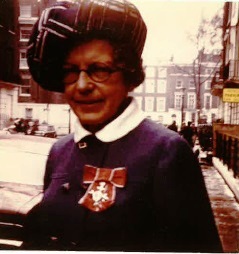New approach to care for children
In 1948, the Children Act established an entirely new approach to the ways children and families were supported. It established a comprehensive childcare service, establishing departments for professional social work. For the first time in the UK, local authorities had wide-ranging responsibilities for children. The Act also led to a new approach towards parent-child relations, encouraging the newly established Children’s Departments to view children as individuals.
Delia Ashworth
 Delia Ashworth came to Coram just after the 1948 Children Act, as its first professional children’s children’s officer.
Delia Ashworth came to Coram just after the 1948 Children Act, as its first professional children’s children’s officer.
Jeanne Kaniuk says, “The act marked a shift away from institutional care for children to family-based care. Society did not understand childcare then as we do now, but it was a time when the thinking about children’s needs and childcare standards was changing.
“As a charity, we were still fostering children up to the age of five and then bringing them to the residential school at Berkhamsted, although our policy was already changing by the end of the war, and the children returned to their foster mothers for the school holidays. Everyone was changing their approach and Delia led the way at Coram, ensuring that children had the chance of a family life in foster families. During that time, the Coram foster parents especially were very vocal; they would petition the Home Office and write to MPs saying it was not good to take the children away from them when they reached school age. The 1948 Children Act marked a sea change for us as for other childcare agencies, as the expectation was for children to grow up in families, not institutions. From then on, those children that came into Coram’s care were placed in foster families where they could grow up if they were not able to return to the care of their mothers and, finally, the residential school closed. Delia was so forward looking. She developed our relationship with Great Ormond Street Hospital and the Tavistock Centre as specialist centres where some of the children with particular difficulties were referred from time to time.
“From the beginning Delia took the needs of the mothers whose children came into the care of Coram very seriously, wanting to ensure that they had support to improve their circumstances and if possible to reclaim their children. Her concern for the mothers was very unusual in the charities supporting children in the 1950s. Delia personally interviewed many of the mothers and kept in touch with their progress. Everyone worked on Saturday mornings because the mothers worked during the week and so if you wanted to see them you had to be there on a Saturday.
“Delia was one of those amazing women from the early 20th century, leaders in emerging professions such as social work, who dedicated their entire lives to their profession and shaped the thinking and practice for generations to come.
“On Saturdays, when the work for the day was finished, she might invite you to have a small sherry. When she went on holiday, she would take the train to Italy with a case full of correspondence. She was deeply loved by the children, mothers and staff. Staff looked up to her enormously. As a result of her work and influence at Coram she was awarded an OBE.”
Barbara Tizard
“Barbara Tizard, who was a psychologist at the Institute of Education and for many years led the work of the Thomas Coram Research Unit, was very interested in adoption. She carried out a most important seminal study where she followed a sample of children who had been in residential care until the age of four. Some then went to their birth mothers and some were adopted. She looked at the progress of the children at different stages as they grew up, working with another pioneer, Jill Hodges, a child adolescent psychotherapist based first at the Thomas Coram Research Unit and later at Great Ormond Street Hospital. Jill has subsequently been one of the Principle Investigators on another longitudinal adoption research project (with Miriam Steele) based at Coram, following up the developments of attachments between adopted children and their adoptive parents.
“Barbara’s work was very important for our understanding of how children who suffer separation from their birth families develop, and the outcomes of different kinds of long-term care. It was the first longitudinal study that looked at adopted children who had been in care and compared their outcomes with those of children returned to their families. The general belief at the time was that children were always better off with their birth mothers almost regardless of the circumstances. Barbara Tizard found the opposite, in that the adopted sample did very well, on the whole better than those returned to their birth families.
“She was a small, fiery lady – very passionate about the work and the families. Her research was extremely influential on the whole profession and on the way we looked at helping children.
“Barbara Tizard’s husband, Jack Tizard, was the Director of the Institute of Education when she worked here. His team conducted significant research in the Coram family centre and the institute’s Thomas Coram Research Unit has our founder’s name in recognition of that early work.”
Useful links
Find out more about Coram’s history
Discover more about children in care in the 20th century
